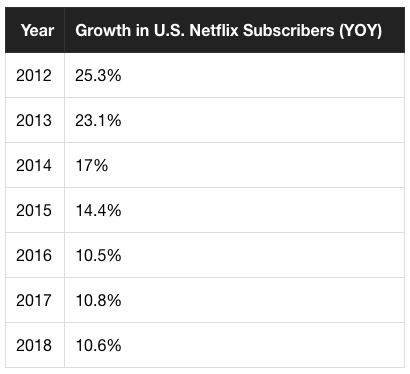Netflix U.S. Growth Is Slowing: Will It Ever Hit Its Goal Of 90 Million Subscribers?

Netflix (NASDAQ:NFLX) may be in nearly half of the 126 million U.S. households, but it thinks it can do better. The company hit 59 million paying U.S. subscribers last quarter, but it wants to hit up to 90 million domestic subscribers.
The problem is that Netflix's growth has slowed in the saturated U.S. market. The people who want to pay a monthly fee for the option to view around 6,000 titles on Netflix's streaming platform have had over 10 years to sign up for the service since its launch date in January 2007.
Netflix's U.S. growth slows
Netflix started in 1998 as a DVD-by-mail business and didn't offer a streaming-only subscription plan in the U.S. until November 2010. Two years later, the video streaming trend was still gaining popularity and Netflix's business was strong at 25.3% year-over-year growth in the U.S. But since then, growth in the U.S. has been dropping each year. For 2018, its U.S. subscriber base grew by just 10.6%.

However, Netflix has said that it wants to eventually hit 60 million to 90 million U.S. subscribers. To reach the high end of that estimate, Netflix would need to add 31 million more domestic accounts.
Can Netflix find 30 million more U.S. subscribers?
Netflix added 1.5 million U.S. subscribers last quarter and is forecasting 1.6 million U.S. net additions for the first quarter of 2019. At this rate, it seems like Netflix may never hit 90 million subscribers.
Netflix's brand awareness is so high in the U.S. that you wonder, Who hasn't already heard of the company and had a chance to subscribe to it? But while Netflix said it's reaching out to pockets of the U.S. where its brand awareness is lower, that may not be the real issue.
The key to Netflix's future domestic growth is likely members of the younger generation who aren't yet paying for their own account, according to a 2018 study from Bernstein. The firm commissioned a 1,000-person survey that showed only 68% of people who use Netflix are actually paying for it. The remaining 32% are sharing an account with someone.
That's not too shocking considering Netflix's most popular plan, the $12.99 standard plan, allows for two screens to be using the platform at one time. But there's no limit to how many people you can let borrow your account login information. Based on Bernstein's survey information, Netflix could potentially be at 87 million subscribers in the U.S. if everyone who had access to the platform were paying for it.
But the most important finding from the survey was the most popular age groups that had access to Netflix. Bernstein found that 82% of the survey responders from ages 30 to 49 had access to the streaming platform, while 44% of those ages 50 to 64 had access, and only 26% of those ages 65 or older had access. So instead of buying expensive technology to crack down on account sharing, Netflix may just need to wait it out until its younger users start paying for their own accounts.
The findings of the survey aren't all that shocking; they're mostly intuitive. The older generations didn't grow up using technology and some of them aren't familiar or comfortable with using the Internet. On the other hand, the younger generations are spending an average of nine hours a day online. They live and breathe the internet. And that's why Bernstein estimates Netflix can easily hit 90 million subscribers within the next decade.
The firm also noted that U.S. cable and satellite TV subscribers peaked at 100 million. So again, Netflix hitting 90 million U.S. subscribers is really not all that absurd. In fact, it will probably happen.
This article originally appeared in the Motley Fool.
Natalie Walters has no position in any of the stocks mentioned. The Motley Fool owns shares of and recommends Netflix. The Motley Fool has a disclosure policy.





















